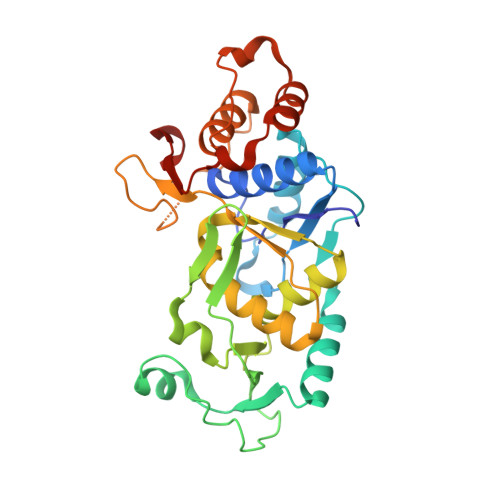Crystal Structure of Glutamyl-Queuosine Trnaasp Synthetase Complexed with L-Glutamate: Structural Elements Mediating tRNA-Independent Activation of Glutamate and Glutamylation of Trnaasp Anticodon.
Blaise, M., Olieric, V., Sauter, C., Lorber, B., Roy, B., Karmakar, S., Banerjee, R., Becker, H.D., Kern, D.(2008) J Mol Biol 381: 1224
- PubMed: 18602926
- DOI: https://doi.org/10.1016/j.jmb.2008.06.053
- Primary Citation of Related Structures:
4A91 - PubMed Abstract:
Glutamyl-queuosine tRNA(Asp) synthetase (Glu-Q-RS) from Escherichia coli is a paralog of the catalytic core of glutamyl-tRNA synthetase (GluRS) that catalyzes glutamylation of queuosine in the wobble position of tRNA(Asp). Despite important structural similarities, Glu-Q-RS and GluRS diverge strongly by their functional properties. The only feature common to both enzymes consists in the activation of Glu to form Glu-AMP, the intermediate of transfer RNA (tRNA) aminoacylation. However, both enzymes differ by the mechanism of selection of the cognate amino acid and by the mechanism of its activation. Whereas GluRS selects l-Glu and activates it only in the presence of the cognate tRNA(Glu), Glu-Q-RS forms Glu-AMP in the absence of tRNA. Moreover, while GluRS transfers the activated Glu to the 3' accepting end of the cognate tRNA(Glu), Glu-Q-RS transfers the activated Glu to Q34 located in the anticodon loop of the noncognate tRNA(Asp). In order to gain insight into the structural elements leading to distinct mechanisms of amino acid activation, we solved the three-dimensional structure of Glu-Q-RS complexed to Glu and compared it to the structure of the GluRS.Glu complex. Comparison of the catalytic site of Glu-Q-RS with that of GluRS, combined with binding experiments of amino acids, shows that a restricted number of residues determine distinct catalytic properties of amino acid recognition and activation by the two enzymes. Furthermore, to explore the structural basis of the distinct aminoacylation properties of the two enzymes and to understand why Glu-Q-RS glutamylates only tRNA(Asp) among the tRNAs possessing queuosine in position 34, we performed a tRNA mutational analysis to search for the elements of tRNA(Asp) that determine recognition by Glu-Q-RS. The analyses made on tRNA(Asp) and tRNA(Asn) show that the presence of a C in position 38 is crucial for glutamylation of Q34. The results are discussed in the context of the evolution and adaptation of the tRNA glutamylation system.
Organizational Affiliation:
UPR 9002 Architecture et Réactivité de l'ARN, Institut de Biologie Moléculaire et Cellulaire du Centre National de la Recherche Scientifique, Université Louis Pasteur, F-67084 Strasbourg Cedéx, France.
















